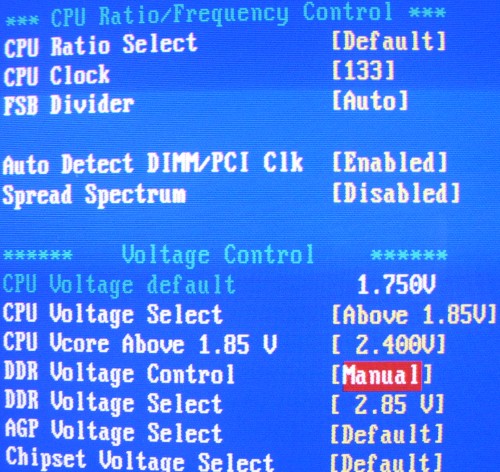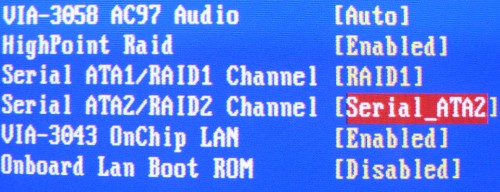BIOS
Award's trusty BIOS takes care of the duties for the AK37 GT/R. Here we have the main voltage configuration screen.

The CPU ratio can either be set to default to auto-detect the CPU, or be manually set up to 14x. The CPU's FSB clock can be manipulated from 100 - 200MHz in 1MHz increments. The FSB divider can either be set to auto (as shown) or either 4/1, 5/1. The 5/1 ratio fits in perfectly with a proposed 166FSB Athlon XP processor. It would keep the sensitive PCI bus at the default 33MHz when running the processor at 166FSB.
The voltage section is something of an eye-opener. You are given the option of applying a quite unprecedented 2.4v to your S462 CPU. I'd only advise going over 2v if you have water or freon-based cooling. Thankfully, you can only access the <1.85v Vcore by manually selecting the 'above 1.85v option'.
DDR voltage goes up to a respectable 2.85v from a stock of 2.5v. AGP voltage manipulation goes up to a high of 1.8v from 1.5v. We're also provided with chipset voltage selection

Along with the extensive voltage selections, we have an array of DDR timings available. DRAM clock settings are either the 133MHz or 166MHz (DDR266, DDR333) that are officially supported, or the unsupported but offered 200MHz (DDR400). We can go down to a CAS Latency of 1.5 clocks, although I couldn't boot at that speed at any MHz.

On-board sound, RAID (both IDE and S-ATA), and on-board LAN can be toggled on and off in BIOS. I've noted that the HPT372 is a 2-channel controller. With that in mind, we cannot use all 4 offered RAID ports together. You can choose 2 out of any 4. Note that S-ATA offers RAID0 and RAID1 support, not RAID0+1.
The usual hardware monitoring options are present, too. The BIOS is highly reminiscent of an ABIT motherboard. It's tweakable with excellent voltage options.









